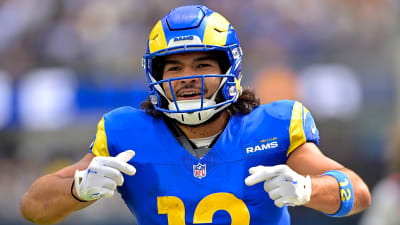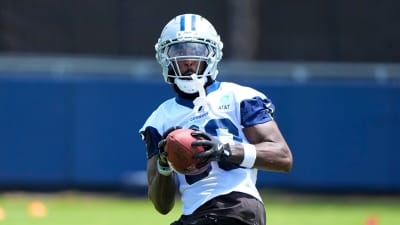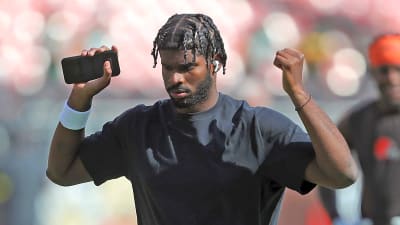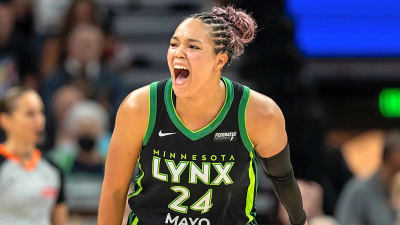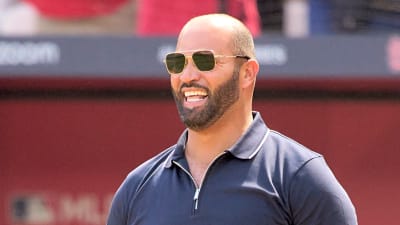
It’s been the postseason of rivalries, and the 2025 NLDS will feature another epic showdown between two NL Central rivals.
The Chicago Cubs will take a short trip up I-94 to take on the Milwaukee Brewers and kick off a best-of-five NLDS matchup. The Brewers, who went 6-7 against the Cubs in the regular season, head into the playoffs as the top seed in the NL and are looking to secure their first World Series title in franchise history.
The Cubs would love nothing more than to rain on their parade and secure their first championship since 2016.
For most of the season, the Brewers have felt like the team of destiny. But everybody knows that the Cubs have as much firepower as any in baseball and are riding some serious momentum from an electric series win against the San Diego Padres in the Wild Card round.
It’s Craig Counsell going up against his successor in Pat Murphy. It’s the division champs going up against their bitter foes. Baseball is often quite poetic, and this is will be another chapter in a storied division rivalry.
Starting Pitching Matchups
The @Cubs and @Brewers have NEVER faced off in the #Postseason … until now!
— MLB (@MLB) October 3, 2025
Two NL Central rivals meet with a spot in the NLCS up for grabs! pic.twitter.com/cbsugOWFP9
*Probably pitchers not official at time of publish
Game 1: Freddy Peralta vs. Colin Rea
- Peralta: 33 GS, 176.2 IP, 2.70 ERA, 204 K, 66 BB, 3.6 fWAR
- Rea: 32 G (27 GS), 159.1 IP, 3.95 ERA, 127, 44, 1.9 fWAR
Freddy Peralta will get the ball in Game 1 for the Brewers. The 29-year-old had a career year on the mound, pitching to a career-low 2.70 ERA, which was the fourth-lowest mark among qualified arms in the National League, and his batting average against of .191 was the third-lowest mark in MLB.
The extra rest should bode well for Milwaukee’s ace. On five days rest this season, he’s throwing to a 2.65 ERA with a .170 opponent batting average and OPS south of .600. Peralta has also been stellar at American Family Field this year, pitching to a 1.77 ERA in his home park.
Peralta was 3-1 in his four starts against Chicago, and in those 21 innings he threw to a 3.43 ERA but had an opponent average of just .164. This game will be a complete tone setter for the series.
Counsell has yet to announce a starter for Game 1, but the schedule is lining up for it to be Colin Rea.
Rea, who was a key member of the Brewers’ pitching staff from 2023-2024, is having a career year on the bump. Throwing to a career-low 3.95 ERA, he’s been utilized as a swingman for Chicago this season. He threw 15 pitches in relief in Game 2 of the NLWCS (1.2 innings of scoreless ball), but that shouldn’t impact his availability for Game 1 of the NLDS.
Since Matthew Boyd, Shota Imanaga, and Jameson Taillon all threw in the NLWCS, Rea is likely the next man up to get the start for Chicago. There’s a certain amount of familiarity here on both sides with Rea, and it will be a fascinating wrinkle in what is a matchup layered with storylines.
Game 2: Quinn Priester vs. Matthew Boyd
- Priester: 29 G (24 GS), 157.1 IP, 3.32 ERA, 132 K, 50 BB 1.9 fWAR
- Boyd: 31 GS, 179.2 IP, 3.21 ERA, 154 K, 42 BB, 3.4 fWAR
Quinn Priester was one of the best stories for the Brewers this season. It was a shaky start to his Brewers tenure to say the least, but he’s evolved into one of baseball’s premier ground-ball artists with a 56.1% ground-ball rate, the fifth-highest in MLB (min. 150 IP).
What was the turning point in the season? His outing on May 2 (his fifth as a Brewer) where he was tagged for seven runs in the second inning against the Cubs at American Family Field. Since that date (24 outings, 134 IP), he is throwing to a 2.89 ERA.
Like I said, the storylines write themselves.
Matthew Boyd last pitched in Game 1 of the NLWCS on Tuesday, meaning he wouldn’t be eligible to pitch for Game 1 of this series but could go in Game 2 on five days rest.
Boyd was an All-Star for the first time in his career in 2025 and emerged as the ace of this staff, throwing to a 3.21 ERA with a WHIP of 1.09. Boyd made two starts against Milwaukee this season and struggled in both, going a total of 10.1 innings and allowing a total of nine runs.
But the postseason is a different beast, and he’s done well in his limited sample size in October. In 16.1 career postseason innings, he’s tossing to a stellar 1.10 ERA. Most recently, in Game 1 of the NLWCS, Boyd went 4.1 innings allowing one run and four hits but was pulled after just 58 pitches.
This is lining up to be a terrific pitching duel, and it would be an enormous one for the Cubs to win before they take this series to Chicago for Game 3.
Game 3: Jose Quintana vs. Shota Imanaga
- Quintana: 24 GS, 131.2 IP, 3.96 ERA, 89 K, 50 BB, 0.8 fWAR
- Imanaga: 25 GS, 144.2 IP, 3.73 ERA, 117 K, 26 BB, 0.9 fWAR
While his return hasn’t officially been announced, all signs are pointing toward Jose Quintana returning from the IL (strained calf) for the NLDS and getting the ball in Game 3 of this series. The 36-year-old was awesome for Milwaukee this season, going 11-7 while pitching to a sub-4.00 ERA.
Quintana, who, of course, spent 3.5 years as a Cub from 2017-2020, has made eight postseason appearances (seven starts), and in those 33 innings he has thrown to a 3.55 ERA. Quintana even got the nod in a decisive Game 3 of the NLWCS against Milwaukee last year as a member of the Mets, going six shutout innings of four-hit ball, a game in which the Mets took down the Brewers.
Shota Imanaga will likely oppose him in this game, and while his second season as a Cub wasn’t quite what his rookie season was, he’s still a mighty talented arm who has shown flashes of dominance when his fastball-splitter combination is at its best.
Imanaga was sharp to start the year, throwing to a 2.65 ERA prior to the All-Star break, but a hamstring injury forced him to miss nearly two months of the season and slowed his momentum in the second half. He made three starts against Milwaukee this year, throwing to a 3.57 ERA with an opponent average of just .190 in 17.2 innings.
Imanaga followed opener Andrew Kittredge in Game 2 against the Padres, going four innings and allowing three hits, two walks, and two runs. He’ll look to feed off of the electric Wrigley Field crowd in this one.
Game 4 (If Needed): Freddy Peralta vs. Jameson Taillon
- Peralta: 33 GS, 176.2 IP, 2.70 ERA, 204 K, 66 BB, 3.6 fWAR
- Taillon: 23 GS, 129.2 IP, 3.68 ERA, 98 K, 27 BB, 1.1 fWAR
This is where receiving the bye is a major advantage for the Brewers, as they can structure their rotation however they would like as opposed to the teams that played in the Wild Card round that won’t have that same level of flexibility.
Game 4 is set for Thursday, October 9, meaning Peralta would get the ball on four days rest should the game be needed.
On four days rest, Peralta has a 2.59 ERA, which is actually lower than his mark on five days rest or more. However, his opponent batting average is 65 points higher and his opponent OPS is nearly 50 points higher when pitching on four days rest as opposed to five. This game will also be on the road, where Peralta’s numbers aren’t quite as solid as his numbers at home (3.71 ERA, .649 OPS).
Opposing him would likely be Jameson Taillon, who got the start in the decisive Game 3 for the Cubs in the NLWCS. Taillon, who has been terrific in his last two seasons with Chicago, gave the Cubs four scoreless innings and allowed just two hits and no walks against the Padres.
The 33-year-old posted a career-low opponent average and WHIP this season and has been a huge part of the Cubs’ pitching staff. At Wrigley Field this season, Taillon’s ERA is over a run lower than on the road, sitting at 3.05.
The Brewers will have the starting pitching advantage, although it will be a tougher task than in Game 1 for Peralta with him being on shorter rest and the matchup being on the road.
Game 5 (If Needed): Quinn Priester vs. Matthew Boyd
- Priester: 29 G (24 GS), 157.1 IP, 3.32 ERA, 132 K, 50 BB 1.9 fWAR
- Boyd: 31 GS, 179.2 IP, 3.21 ERA, 154 K, 42 BB, 3.4 fWAR
Should this series go the distance, the Brewers would likely roll out Priester in a win-or-go-home matchup. On four days rest, Priester has a 2.58 ERA on the year (as a starter) with an opponent OPS that is over 140 points lower than pitching on five days rest.
For Chicago, they would have their best arm at their disposal in this elimination game in Boyd. Should this be what the teams decide to roll with, it would be a rematch of the pitching matchup from Game 2 of this series.
Before receiving the loss on the final weekend of the regular season, the Brewers won a whopping 19 straight games where Priester pitched. Conversely, Boyd also went an impressive 14-8 this season, which was tied for the fourth-most wins in the NL.
The Brewers own the third-best home record in baseball at 52-29 this season. The Cubs were the fourth-best road team in MLB at 42-39. This would set up to be one incredible elimination game at American Family Field.
Key Storylines To Watch: Milwaukee Brewers
Can the Offense Get Back On Track?
The Brewers have a 118 wRC+ since the All-Star break, which is tied for the third-highest mark in baseball over that stretch. When this offense is swinging it the way that it was in August, where they posted a 134 team wRC+, the Brewers are as tough of a team to beat as any.
The offense cooled down heading into October, though, which creates some concern. They had a 101 wRC+ in September (14th), and they have a 90 wRC+ since September 15.
William Contreras is hitting just .220 in his last 12 games. He’s also still dealing with an injury to his glove hand that kept him out of the lineup in the final two regular season games, but Pat Murphy said it won’t keep him out of the NLDS. Still, being the X-factor that he is, the success of this offense could hinge on his performance.
Likewise, Jackson Chourio hit only .200 with an OPS south of .600 in September, slumping after returning from the injured list at the end of August. Isaac Collins is batting .133 across his last 12 games, Sal Frelick has a 75 wRC+ in his last 41 plate appearances, and Caleb Durbin has a 61 wRC+ over the last two weeks of the regular season.
This is a lineup that thrived because it had 10 hitters finish the year with a wRC+ of 105 or greater (min. 200), but many of them are hitting a cold spell right before October.
This is a very capable offense when things are clicking, and we’ve seen that over long stretches this season. Will the week off be just what the offense needed to get back on track, or will the slump continue? That remains to be seen.
Plain and Simple: Can They Buck Their Trend of Early Exits?
It’s been an unfortunate trend of early postseason exits for Milwaukee, and now expectations couldn’t be higher. Will they feed off of that energy, or will the pressure be too much for this team to overcome? Only time will tell.
Here is a list of the Brewers’ most recent postseason exits:
- 2019: Loss NLWCG vs. Nationals, 1-0
- 2020: Loss NLWCS vs. Dodgers, 2-0
- 2022: Loss NLDS vs. Braves, 3-1
- 2023: Loss NLWCS vs. Diamondbacks, 2-0
- 2024: Loss NLWCS vs. Mets, 2-1
From 2019-2023, who was at the helm for the Brewers during their heartbreaking stretch of early exits? Craig Counsell, of course.
Either the club’s former skipper adds to the organization’s dreadful postseason history, or toppling Counsell and the Cubs could be the first step in this team reaching the mountaintop. You couldn’t write it any better than that.
Key Storylines To Watch: Chicago Cubs
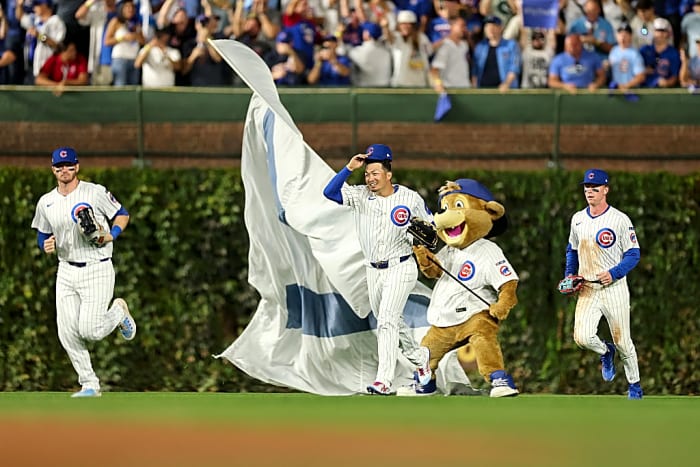
Can the Cubs Slug Their Way to the NLCS?
On the flip side, if the Cubs are going to win this series, it’ll likely have to be their bats that get them to the NLCS.
As far as firepower goes, the Cubs can slug with the best of them. This is a team that finished sixth in homers (223) and slugging percentage (.430) and fourth in ISO (.181). In September, this team hit 37 homers (fifth most in MLB) compared to the Brewers’ mark of 17 (tied for second last in baseball).
We saw their bats come alive at times throughout the Wild Card round, too.
Pete Crow-Armstrong went 3-for-4 with a clutch RBI in Game 3, Kyle Tucker is starting to hit is stride after returning from the IL, Seiya Suzuki became the first player in MLB history to homer in his final four games of the regular season and his first postseason game, and the Cubs’ home run leader — Michael Busch — hit a monumental long ball on Thursday to lead the Cubs to victory.
Point being, this team can get that huge hit when they need it most, and their ability to slug is the huge separator between them and the Brewers. There are questions about whether or not Milwaukee can match their octane, especially with Contreras dealing with his injury and the offense as a whole struggling to hit for power as of late.
Perhaps the Wild Card series gave the Cubs time to get hot just in time for this marquee showdown.
Can the Rotation Compete?
Losing Cade Horton really puts the Cubs behind the eight ball moving forward. While he hasn’t been ruled out for the NLDS just yet, his status remains unclear as he recovers from a fractured rib. The rest of the Cubs’ rotation will need to pick up the slack as we head deeper into October.
Overall, Cubs starters had the second-best ERA since the All-Star break at a 3.49, but a lot of that had to do with Horton’s stellar production. Boyd and Imanaga were the two that struggled down the stretch, but they spearhead the rotation and will now have even more pressure to produce.
It will be fascinating to see how the rotation competes with a fully rested Brewers rotation that finished with the third-best ERA in baseball this year.
Battle of the Bullpens
The Brewers have the advantage of a fresh bullpen, while the Cubs obviously had to tap into their “A” arms this week. However, with the exception of a nearly disastrous Brad Keller outing in Game 3, it was a unit that held its own against San Diego.
Still, the Brewers’ bullpen ranked third in MLB in the second half in ERA (3.09), while the Cubs’ unit ranked 18th (4.13). Both teams got major reinforcements back before the postseason (Daniel Palencia for the Cubs, Trevor Megill for the Brewers), and bullpens often can be the difference maker in these types of series.
In September, the Brewers had the fourth-lowest bullpen ERA (2.91) while the Cubs ranked seventh (3.21). Both units are hot, both are capable, and both will need to be managed perfectly in a series where there is little margin for error.
Boy, are we in for a treat.
Prediction
Brewers in Five
When the Brewers are playing their brand of baseball at the highest level, they’re nearly impossible to beat. We saw that countless times throughout the regular season. It’s why they enter the postseason as the overall No. 1 seed, and it’s why their run differential of +172 was the best in baseball.
But first-round postseason exits have also been a trend for this ball club lately, and it’s concerning to see this team lose some of its momentum over the final couple of weeks of the regular season while the Cubs appear to be hitting their strid at the right time.
While the best regular season team doesn’t always prosper in October, the little things will be magnified in this series, and I believe the Brewers do those things at a higher level than any in baseball. That should give them the edge in what should be an incredibly competitive series.
More must-reads:
- Yankees ride rookie Cam Schlittler's historic performance to ALDS with Red Sox elimination
- Dodgers announce Game 1 starter vs. Phillies
- The 'Active 30-homer MLB seasons leaders' quiz
Breaking News
Trending News
Customize Your Newsletter
 +
+
Get the latest news and rumors, customized to your favorite sports and teams. Emailed daily. Always free!
